Mbira
Mbira (pronounced m-BEER-ra , /əmˈbɪərə/) are a family of musical instruments, traditional to the Shona people of Zimbabwe. They consist of a wooden board (often fitted with a resonator) with attached staggered metal tines, played by holding the instrument in the hands and plucking the tines with the thumbs (at minimum), the right forefinger (most mbira), and sometimes the left forefinger. Musicologists classify it as a lamellaphone, part of the plucked idiophone family of musical instruments. In Eastern and Southern Africa, there are many kinds of mbira, often accompanied by the hosho, a percussion instrument. It is often an important instrument played at religious ceremonies, weddings, and other social gatherings.
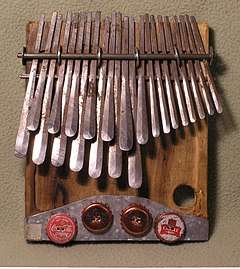 Mbira dzavadzimu | |
| Other instrument | |
|---|---|
| Other names | finger harp, gourd piano, ikembe, kalimba, kilembe, likembe, likimba, marimbula, mbla, sansa, sansu, sanza, thumb piano, timbrh, zanzu |
| Classification | Lamellophone, Plucked Idiophone |
| Hornbostel–Sachs classification | 122.1 (Plucked idiophone) |
| Timbre | clear, percussive, chimelike |
| Volume | low |
| Attack | fast |
| Decay | moderate |
| Playing range | |
|
Varies, see Tuning low to medium | |
| More articles or information | |
| Mbira music | |
A modern interpretation of the instrument was commercially produced and exported by ethnomusicologist Hugh Tracey from the 1950s onward, popularising similar instruments outside of Africa; Tracey's design was modeled after the mbira nyunga nyunga and named 'Kalimba' after an ancient predecessor of the mbira family of instruments.
Mbira became popularized largely due to the success of Thomas Mapfumo in the 1980s,[1] who included mbira on stage accompanying modern rock instruments such as electric guitar and bass, drum kit, and horns. Mapfumo's arrangements included numerous songs directly drawn from traditional mbira repertoire. Other notable influencers bringing mbira music out of Africa are: Dumisani Maraire, who brought marimba and karimba music to the American Pacific Northwest; Ephat Mujuru, who was one of the pioneer teachers of mbira dzavadzimu in the United States; the writings and recordings of Zimbabwean musicians made by Paul Berliner. Claire Jones, a student of Dumisani Maraire in the 1970s, has been playing and teaching mbira for more than 40 years and is Festival Coordinator for Zimfest, a Zimbabwean Music Festival held annually in North America that offers many opportunities to learn and listen to mbira.[2][3]
Joseph H. Howard and Babatunde Olatunji have both suggested that mbira (and other metal lamellaphones) are thoroughly African, being found only in areas populated by Africans or their descendants.[4] Similar instruments were reported to be used in Okpuje, Nsukka area of the south eastern part of Nigeria in the early 1900s.[5]
History
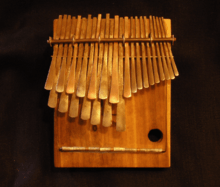
Various kinds of plucked idiophones and lamellaphones have existed in Africa for thousands of years. The tines were originally made of bamboo but over the years metal keys have been developed. These types of instrument appear to have been invented twice in Africa: a wood or bamboo-tined instrument appeared on the west coast of Africa about 3,000 years ago, and metal-tined lamellophones appeared in the Zambezi River valley around 1,300 years ago.[6] Metal-tined instruments traveled all across the continent, becoming popular among the Shona of Zimbabwe (from which the word mbira comes) and other indigenous groups in Zimbabwe and Mozambique.[7] The mbira differentiated in its physical form and social uses as it spread. Kalimba-like instruments came to exist from the northern reaches of North Africa to the southern extent of the Kalahari Desert, and from the east coast to the west coast, though many or most groups of people in Africa did not possess mbiras. There were thousands of different tunings, different note layouts, and different instrument designs, but there is a hypothetical tuning and note layout of the original metal-tined instrument from 1,300 years ago, referred to as the 'kalimba core'.[8][9]
In the mid 1950s mbira instruments were the basis for the development of the kalimba, a westernized version designed and marketed by the ethnomusicologist Hugh Tracey, leading to a great expansion of its distribution outside Africa.[10][11]
Acoustics
Lamellophones are instruments which have little tines, or "lamellae", which are played by plucking. Unlike stringed instruments or air-column instruments like flutes, the overtones of a plucked lamella are inharmonic, giving the mbira a characteristic sound. The inharmonic overtones are strongest in the attack and die out rather quickly, leaving an almost pure tone. When a tine is plucked, the adjacent tines also create secondary vibrations that increase the harmonic complexity of an individual note.[12]
Rhythm
Mbira music, like much of the sub-Saharan African music traditions is based on cross-rhythm. An example from the kutsinhira part of the traditional mbira dzavadzimu piece "Nhema Musasa" is given by David Peñalosa, who observes that the left hand plays the ostinato "bass line," while the right hand plays the upper melody. The composite melody is an embellishment of the 3:2 cross-rhythm (also known as a hemiola).[13]
Tuning
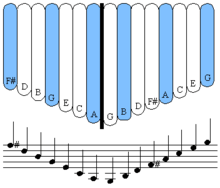
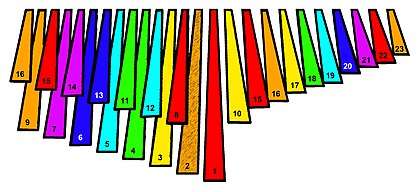
* Same color keys are the same notes (usually octaves)
* Key “1” is the lowest note, ascending to the highest note key “23”
* Key “2” is often only found on the mavembe tuning
* Some mbira have extra keys (e.g. extra “17” on left side, or higher notes on the right beyond key “23” are most common)
* Note intervals can vary, but all the octaves are divided into a heptatonic scale, many being diatonic or at least nearly diatonic
* This diagram does not represent every mbira dzavadzimu, but does represent the most common layout
* It is important to note that the key numbering and color codes portrayed here are arbitrary and simply to communicate the layout (not traditional approach)
It is common on African mbira and other lamellophones to have the lowest notes in the center with higher notes to the far left and the far right—this is an ergonomic nicety, in that the thumb can pivot such that all the tines are easy to reach. However, traditional African tunings use notes that do not lie on the grid of the Western tempered scale, and traditional mbira note layouts are often idiosyncratic, sometimes with adjacent tines making part of a scale, but then an odd note thrown in that defies the pattern.
Historically, mbira tunings have not mapped exactly onto Western scales; it is not unusual for a seven-note sequence on a mbira to be "stretched" over a greater range of frequencies than a Western octave and for the intervals between notes to be different from those in a Western scale. Tunings have often been idiosyncratic with variations over time and from one player to another. A mbira key produces a rich complex of overtones that varies from one instrument to another depending on its maker's intentions and accidents of fabrication, such that some instruments simply sound better when some notes of a familiar tuning are pushed.[14] With the increased popularity of the mbira dzavadzimu in North America, Europe, and Japan in recent decades, Zimbabwean mbira makers have tended to tune their instruments more uniformly for export, but much variation is still found among mbira in their homeland.[15]
Tunings vary from family to family referring to relative interval relationships and not to absolute pitches. The most common tuning played throughout Zimbabwe and among non-Zimbabwean mbira players worldwide is Nyamaropa, similar to the western Mixolydian mode.[16][17][18][19][20] Names may also vary between different families; Garikayi Tirikoti has developed a "mbira orchestra" that has seven different tunings, each starting on a different interval of the same seven-note scale, where it is possible to play all instruments in a single performance.[21] The seven tunings that Garikayi uses are: Bangidza, Nyabango, Nhemamusasa, Chakwi, Taireva, Mahororo, and Mavembe (all of which are also names of traditional songs save for Mavembe and Nyabango). The closest to what is commonly named "Nyamaropa" is his "Nhemamusasa" tuning.[22][23]
Specific tunings
Common names for tunings are:
- Nyamaropa (close to Mixolydian mode) (considered the oldest and most representative in Shona culture) It emphasizes togetherness through music, creating polyrhythms through having two Mbira players at once, having singing styles accompany an Mbira such as Huro (High emotional notes that are at the top of a singer's range) & Mahon'era (a soft breathy voice at the bottom of the singer's range) or both elements. A single Mbira is considered incomplete for a performance.[24]
- Dambatsoko (close to Ionian mode), played by the Mujuru family. The name refers to their ancestral burial grounds.
- Dongonda, usually a Nyamaropa tuned mbira with the right side notes the same octave as the left (an octave lower than usual).
- Katsanzaira (close to Dorian mode), the highest pitch of the traditional mbira tunings. The name means "the gentle rain before the storm hits".
- Mavembe (also: Gandanga) (close to Phrygian mode), Sekuru Gora claims to have invented this tuning at a funeral ceremony. The mourners were singing a familiar song with an unfamiliar melody and he went outside the hut and tuned his mbira to match the vocal lines. Other mbira players dispute that he invented it.
- Nemakonde (close to Phrygian mode), same musical relationship as the mavembe, but the nemakonde tuning is a very low pitched version.
- Saungweme (flattened whole tone, approaching seven tone equal temperament).
Variants
Mbira dzavadzimu
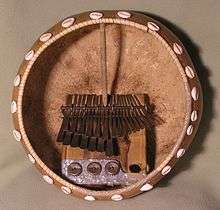
In Shona music, the mbira dzavadzimu ("voice of the ancestors", national instrument of Zimbabwe[25]) is a musical instrument that has been played by the Shona people of Zimbabwe for thousands of years. The mbira dzavadzimu is frequently played at religious ceremonies and social gatherings called mabira (sing. "bira").
A typical mbira dzavadzimu consists of between 22 and 28 keys constructed from hot- or cold-forged metal affixed to a hardwood soundboard (gwariva) in three different registers—two on the left, one on the right.
While playing, the little finger of the right hand is placed through a hole in the bottom right corner of the soundboard, with the little finger entering from the front of sound board, and the ring finger and middle finger reaching around the back to stabilize the instrument. This leaves the thumb and index finger of the right hand open to stroke the keys in the right register from above (thumb) and below (index finger). The fingers of the left hand stabilize the left side of the instrument, with most fingers reaching slightly behind the instrument. Both registers on the left side of the instrument are played with the left thumb. Some mbira possess an extra key in the upper left register which is hit from below by the left index finger.
Bottle caps, shells, or other objects ("machachara"[26]) are often affixed to the soundboard to create a buzzing sound when the instrument is played. In a traditional setting, this sound is considered extremely important, as it is believed to attract ancestral spirits.
During a public performance, an mbira dzavadzimu is frequently placed in a deze (calabash resonator) to amplify its sound.
The mbira dza vadzimu is very significant in Shona religion and culture, considered a sacred instrument by the Shona people. It is usually played to facilitate communication with ancestral spirits, bringing the spirit of the dead back on its homestead.[27] Within the Shona tradition, the mbira may be played with paired performers in which the kushaura, the caller, leads the performed piece as the kutsinhira, the responder, "interlocks" a subsequent part.[28] The ritual is known as the Bira. During these all-night ceremonies, people call upon the spirits to answer questions. The variations of notes in an Mbira piece aid the participants in going into trance, which in Shona culture aids the spirits in taking over the participant's body.[29]
Albert Chimedza, director of the Mbira Centre in Harare, has estimated that "there are at most ten thousand people in the world who play mbira."[1]
Mbira Nyunga Nyunga
The nyunga nyunga which normally has 15 keys, originated from Manicaland where it traditionally played the entertainment role during social gatherings and commemorations.[27] Jeke (Jack) Tapera introduced the mbira nyunga nyunga in the 1960s from Tete province of Mozambique to Kwanongoma College of African music (now United College of Music) in Bulawayo. Two keys were then added to make fifteen (Chirimumimba, 2007), in two rows. The mbira nyunga nyunga is similar in construction to the mbira dzavadzimu, but has no hole in the soundboard. Key pitch radiates out from the center, rather than from left to right.
Zimbabwe's Dumisani Maraire originated mbira nyunga nyunga number notation. The upper row keys (from left) are keys 2, 4, 6, 8, 10, 12, and 14 while the bottom row keys are notated as 1, 3, 5, 7, 9, 11, 13, and 15. Maraire brought awareness of this instrument to the United States when he came to the University of Washington as a visiting artist from 1968–1972.
Recently a Midlands State University (Gweru, Zimbabwe) lecturer in the department of music and musicology has suggested a letter notation; the upper keys as (from first left upper key) E, D, C, F, C, D, and E and the lower or bottom keys as (from the first lower key) A, G, F, A, F, C, D, and E. But the Maraire number notation has remained the internationally accepted system (Chirimumimba, 2007).
Njari mbira
Njani mbira has 30 to 32 keys and was also originated from Zimbabwe particularly Masvingo and Makonde.[27]
Nhare
The nhare has 23 to 24 keys and was originated from Zimbabwe. In the Zimbabwean tradition, nhare was used for rituals of communicating with Musikavanhu or Nyadenga (God).[27]
Mbira matepe
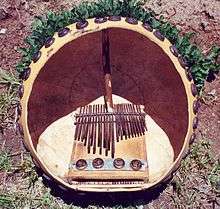
Mbira matepe which has 26 keys originated from along the borders of Zimbabwe and Mozambique.[27]
Outside Africa
The Hugh Tracey kalimbas are tuned diatonically in the key of G. The arrangement of the notes on the Hugh Tracey kalimba borrows from the typical scheme with the lowest notes in the center and the upper notes on the left and the right, with the notes in the ascending scale alternating strictly right-left and going outwards towards the two sides.
The diatonic western kalimba tuning which Tracey used was practical for a worldwide instrument—with hundreds of African kalimba tunings, the chosen Western standard would maximize the number of people who would immediately connect with the kalimba. The practicality of this note arrangement, with notes going up the scale in a right-left-right-left progression, is that modal 1-3-5 or 1-3-5-7 chords are made by playing adjacent tines. If chords are played in the lower octave, the same notes will appear on the opposite side of the kalimba in the upper octave, which makes it very easy to simultaneously play a melody in the upper octave and an accompanying harmony in the lower octave. So, the arrangement of notes on the Hugh Tracey kalimba (and on virtually any kalimba that copies the instrument) makes certain complex musical operations very simple.[30]
Alternative tunings are possible, as the tines of most kalimbas are easily pushed in and out to sharpen or flatten their pitch. Some alternative tunings simply change the key of the kalimba, without changing the note layout scheme. C major is a popular tuning, sold by multiple manufacturers. Other alternative tunings move the kalimba to non-modal scales (such as Middle-Eastern scales). Each note of the kalimba can be tuned independently (unlike a guitar), so any scale, western or non-western, is possible, and traditional African scales are still accessible to this modern African instrument. Composer Georg Hajdu has tuned the Hugh Tracey alto kalimba to the chromatic steps of the Bohlen–Pierce scale in a piece called Just Her – Jester – Gesture. The Bohlen–Pierce scale subdivides the just twelfth into 13 steps.
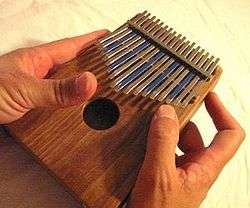 Hugh Tracey treble kalimba
Hugh Tracey treble kalimba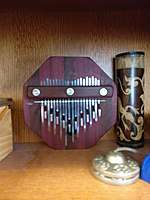 An octagonal mbira of high craftsmanship which spans two octaves.
An octagonal mbira of high craftsmanship which spans two octaves.
Related instruments
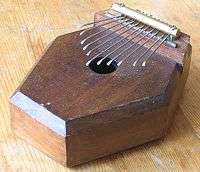
Instruments related to or inspired by the mbira include:
- Array mbira, a modern invention consisting of as many as 150 tines configured in a special order based on the circle of fifths (see Isomorphic keyboard).
- Gravikord, an electrified double harp that is a modern kora and kalimba hybrid, inspired by the cross rhythms of the mbira. The Gravikord was invented in 1986 by Bob Grawi an American musician and artist. It is also tuned in the key of G major/E minor in an extended version of the Hugh Tracey kalimba tone layout with a range of 3 1⁄2 octaves. Music and playing techniques learned on this kalimba can be easily transferred and played on the Gravikord.
- Guitaret, an electric lamellophone made by Hohner and invented by Ernst Zacharias, in 1963.
- Ikembe, an instrument common among the Hutu of Rwanda, Burundi, and eastern DR Congo.
- Modern kalimba, the mbira inspired instruments of Hugh Tracey. Named after the original kalimba (ancestor of mbira).
- Kisanji among Ngala-speaking people of western DR Congo and eastern Congo Republic.
- Thoom Otieno (also tom, thom or toom), popular in Gambela Region, in Western Ethiopia on the border of South Sudan.
In popular culture
On May 21, 2020, as part of Zimbabwe Culture Week, Google honoured the mbira with a doodle which included a button allowing users to hear and play the instrument virtually. The doodle also featured the animated story of a young girl who learns to play the mbira and inspires a new generation of mbira players after becoming an established artist as an adult.[31]
Even though it is set in Botswana, the 1980 movie The Gods Must Be Crazy features a character playing the mbira.[32]
Players
Citations
- "Making music: Zimbabwe's mbira". BBC News – Africa. Retrieved 2014-07-09.
- "Claire Jones | School of Music | University of Washington". music.washington.edu. Retrieved 2020-05-22.
- "About Zimfest | Zimbabwean Music Festival". zimfest.org. Retrieved 2020-05-22.
- Olatunji, Babatunde (1965). Musical Instruments of Africa: Their Nature, Use, and Place in the Life of a Deeply Musical People (1st ed.). New York, New York: John Day Company, Inc. p. 48. ISBN 0-381-97013-2.
- "Sub-Saharan African Instruments at the National Music Museum". collections.nmmusd.org. Retrieved 2020-05-29.
- Kubik, Gerhard (1998) Kalimba – Nsansi – Mbira. Lamellophone in Afrika. With CD. Berlin: Museum für Völkerkunde
- Falola, Toyin (2000). African Cultures and Societies Before 1885. Durham, NC: Carolina Academic Press. pp. 274–275. ISBN 0-89089-769-7.
- Gimenez Amoros, Luis; Tracing the Mbira Sound Archive in Zimbabwe; Routledge; Abdingdon-on-THames, Oxfordshire, England: 2018. 144 pp. ISBN 978-1138585102
- Berliner, Paul F.; Soul of Mbira: Music and Traditions of the Shona People of Zimbabwe; University of California Press; Oakland, California: 1979. 280 pp. ISBN 978-0520033153
- "My Story of Hugh Tracey – Kalimba Magic". www.kalimbamagic.com. Retrieved 2020-05-01.
- "Hugh Tracey Kalimbas". www.danmoi.com. Retrieved 2020-05-01.
- Chapman, David M. F. (January 2012). "The tones of the kalimba (African thumb piano)". The Journal of the Acoustical Society of America. 131 (1): 945–950. doi:10.1121/1.3651090.
- Peñalosa, David (2010). The Clave Matrix; Afro-Cuban Rhythm: Its Principles and African Origins p. 35. Redway, CA: Bembe Inc. ISBN 1-886502-80-3.
- McNeil, L. E.; Mitran, S. (2008-02-01). "Vibrational frequencies and tuning of the African mbira" (PDF). The Journal of the Acoustical Society of America. 123 (2): 1169–1178. doi:10.1121/1.2828063. ISSN 0001-4966.
- "Amazon.com: Kalimba Thumb Piano 17 Key,Portable Finger Piano/Mbira/Sanza Kit for Kids and Adults, Solid KOA With Key Locking System,Tune Hammer,Study Instruction,Cloth Bag,Study Guide Sticke: Musical Instruments". www.amazon.com. Retrieved 2020-05-30.
- "Tune Your Mbira". MBIRA. Retrieved 2020-05-30.
- "N. Scott Robinson-World Music and Percussion, Frame Drums, Riq, Tambourines". www.nscottrobinson.com. Retrieved 2020-05-30.
- "Mbira webstore (world wide shipping) | MBIRA ZVAKANAKA" (in Japanese). Retrieved 2020-05-30.
- Williams, Michael. Getting Started with Mbira dzaVadzimu (PDF).
- Tracey, Andrew. "THE SYSTEM OF THE MBIRA". JOURNAL OF INTERNATIONAL LIBRARY OF AFRICAN MUSIC.
- "Mbira Junction / Garikai Tirikoti". www.mbirajunction.com. Retrieved 2020-05-30.
- Williams, Michael. Getting Started with Mbira dzaVadzimu (PDF).
- "Mbira: Constraint and Mobility in Shona Society". www2.kenyon.edu. Retrieved 2020-05-30.
- Alves, William (2009). Music of the Peoples of the World. Boston, MA: Schirmer. pp. 66–67. ISBN 978-0-495-50384-2.
- "Music in Zimbabwe". Nordiska Afrikainstitutet. March 16, 2006. Archived from the original on December 26, 2007. Retrieved December 17, 2007.
The instrument is, in slightly varying forms, several centuries old and is found in many parts of Africa, but only in Zimbabwe has it risen to become a national instrument
- Williams, B. Michael. (2001) Learning Mbira: A Beginning. Everett, PA: HoneyRock. ISBN 0-9634060-4-3
- Reporter, Staff. "The irony of mbira instrument". Southern Times Africa. Retrieved 2016-04-15.
- Berliner, Paul (1978). The Soul of Mbira (1st Paperback ed.). Berkeley, Los Angeles, London: University of California Press. pp. 17–18. ISBN 0-520-04268-9.
- Alves, William (2009). Music of the Peoples of the World. Boston, MA: Schirmer. pp. 64. ISBN 978-0-495-50384-2.
- "Chords on the 17-Note Kalimba in C - Kalimba Magic". www.kalimbamagic.com. Retrieved 2020-05-29.
- Celebrating Mbira
- "Gods Must Be Crazy, 1980 song". YouTube. Retrieved 13 June 2020.
General references
- Berliner, Paul (c. 1978). The Soul of Mbira: Music and Traditions of the Shona People of Zimbabwe. Berkeley: University of California Press.
- Fowler, Andy (2020) Discover Mbira : Ancient Zimbabwean Trance Music. Mbira Magic.
- Fowler, Andy (2015) Unlocking Mbira : Chord Progression and System of Mbira Workbook. Mbira Magic.
- Gahadzikwa, Fungai; Fowler, Andy (2016) Traditional Mbira Song Book. Mbira Magic.
- Howard, Joseph H. (1967). Drums in the Americas. New York City: Oak Publications.
- Kwenda, Forward; Fowler, Andy (2019) Learn to Play Mbira : Traditional Songs and Improvisation. Mbira Magic.
- Mutwa, Credo Vusa'mazulu (1969). My people: the incredible writings of Credo Vusa'mazulu Mutwa. Johannesburg: Blue Crane Books.
- Tracey, Andrew (1970). "The Matepe Mbira Music of Rhodesia" (PDF). Journal of the African Music Society. 4 (4): 37–61. doi:10.21504/amj.v4i4.1681

- Tracey, Hugh (1961). The evolution of African music and its function in the present day. Johannesburg: Institute for the Study of Man in Africa.
- Tracey, Hugh (1969). "The Mbira class of African Instruments in Rhodesia (1932)". African Music Society Journal. 4 (3): 78–95. doi:10.21504/amj.v4i3.1439

- Warner Dietz, Betty; Olatunji, Michael Babatunde (1965). Musical Instruments of Africa; Their Nature, Use, and Place in the Life of a Deeply Musical People. New York City: John Day Company.
External links
- MbiraMagic.Com Mbira Education Website
- Mbira.Online : Mbira Masters Video and Notation Archive
- Mbira.org, "the non-profit organization devoted to Shona mbira music", based in Berkeley, California
- sympathetic-resonances.org. A free online tool for transcriptions of various mbira types, like Mbira dzavadzimu, Matepe or Karimba. Mbira pieces can be auditioned in the web browser, with audio loops synthesized from actual instrument samples.
- Zimfest.org, a Zimbabwean Music Festival held annually in North America that offers many opportunities to learn and listen to mbira.
Archived Link - Mbira.co.zw, "A community of mbira players, researchers, makers & lovers, for the enhancement of the Mbira, music & fashion. Mbira Transfiguration & Permanence", based in Harare, Zimbabwe